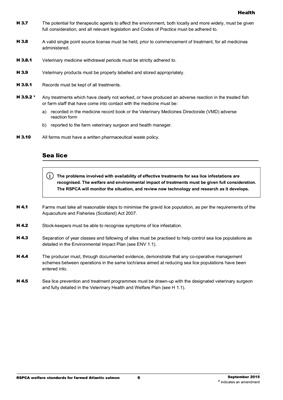
Health
RSPCA welfare standards for farmed Atlantic salmon 6 September 2015
* indicates an amendment
H 3.7 The potential for therapeutic agents to affect the environment, both locally and more widely, must be given
full consideration, and all relevant legislation and Codes of Practice must be adhered to.
H 3.8 A valid single point source license must be held, prior to commencement of treatment, for all medicines
administered.
H 3.8.1 Veterinary medicine withdrawal periods must be strictly adhered to.
H 3.9 Veterinary products must be properly labelled and stored appropriately.
H 3.9.1 Records must be kept of all treatments.
H 3.9.2 * Any treatments which have clearly not worked, or have produced an adverse reaction in the treated fish
or farm staff that have come into contact with the medicine must be:
a) recorded in the medicine record book or the Veterinary Medicines Directorate (VMD) adverse
reaction form
b) reported to the farm veterinary surgeon and health manager.
H 3.10 All farms must have a written pharmaceutical waste policy.
Sea lice
The problems involved with availability of effective treatments for sea lice infestations are
recognised. The welfare and environmental impact of treatments must be given full consideration.
The RSPCA will monitor the situation, and review new technology and research as it develops.
H 4.1 Farms must take all reasonable steps to minimise the gravid lice population, as per the requirements of the
Aquaculture and Fisheries (Scotland) Act 2007.
H 4.2 Stock-keepers must be able to recognise symptoms of lice infestation.
H 4.3 Separation of year classes and fallowing of sites must be practised to help control sea lice populations as
detailed in the Environmental Impact Plan (see ENV 1.1).
H 4.4 The producer must, through documented evidence, demonstrate that any co-operative management
schemes between operations in the same loch/area aimed at reducing sea lice populations have been
entered into.
H 4.5 Sea lice prevention and treatment programmes must be drawn-up with the designated veterinary surgeon
and fully detailed in the Veterinary Health and Welfare Plan (see H 1.1).
i